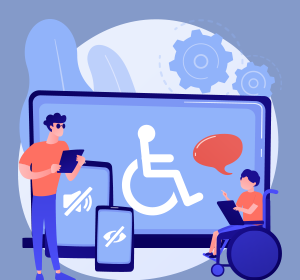Accessibility
Web Accessibility ensures that everyone can access the content and functionalities of the website regardless of any physical barriers. Permanent disability aside, the website should also make it easier for people with any other type of disability such as temporary, situation, or conditional disabilities.

Web Accessibility ensures that everyone can access the content and functionalities of the website regardless of any physical barriers. Permanent disability aside, the website should also make it easier for people with any other type of disabilities such as temporary, situation or conditional disabilities.
Statistics about Accessibility
- 15% of the world's population lives with some form of disability, 2-4% of whom have significant functioning
- 2.2% of India's population lives with physical or mental disabilities.
- 13.9 million people have disabilities in the UK, including 19% of working-age adults.
- 20% of Australians have a disability and no. of people aged 65 or over will reach 6.2 million by 2042.
- 56.7 million Americans are currently disabled, and no. of people aged 65 or over is expected to double to 98 million by 2060.

So, what does all this mean? If your website is not accessible, it means that you have excluded 20% of the world population from the conversation on your website. According to a survey, 71% of users with disabilities are leaving a website that is not accessible. Hence, it is significant that the website is accessible to everyone to offer equal access to people with disabilities.
Key Challenges Faced by People with Disabilities
-

Visual Disabilities
- Inability to distinguish text without enlargement, especially small text.
- Difficulty in distinguishing colors between red & green, red & black, etc.
- Difficulty distinguishing low-contrast text and graphics.
- Equivalent to see in shades of black, grey, and white.
- No vision (or extremely low vision).
-

Motor Disabilities
- Inability or difficulty to use hands.
- Pain when moving hands or other parts of the body.
- Tremors in hands, making it difficult to use a mouse.
- Slow movements of the hands or other parts of the body (feet, arms, elbows, head, etc.) used for computer input as an alternative to the hands.
-

Cognitive Disabilities
- Cognitive overload with large amounts of information.
- Limited problem-solving skills.
- Difficulty understanding or using Math.
- Attention deficit or distractibility.
- Short-term memory deficits.
-

Speech Disabilities
- Inability or difficulty to produce speech sounds.
- Difficulty maintaining speech fluency.
- The difficulty of distinguishing speech sounds in languages.
- Inability to produce a speaking voice.
-

Auditory Disabilities
- Difficulty or complete inability to hear sounds.
- May have difficulty understanding even loud speech.
- Some people understand sign language better than written language.
Assistive Technologies for Users with Different Abilities
Speech Disabilities
- Touch screens
- Alternative keyboards
- Single switch devices
- Eye tracking technologies
- Speech generating software
- Word prediction software
Visual Disabilities
- Screen reader
- Screen magnifier
- Braille Displays
- Contrast enhancement or color reversal software
Auditory Disabilities
- Hearing aids
- Transcripts
- Cochlear implants, and/or other devices
Cognitive Disabilities
- Screen readers
- Screen overlays
- Ad blockers and other similar tools
- Personal assistants(human beings)
Motor Disabilities
- Vertical Keyboard with Mouse Stick
- One Handed Keyboard
- Expanded Keyboard with Raised Sections Between Keys
- Speech recognition software
- Head wand
- Mouth stick
Our Offerings
At Quadrant Technologies, we provide a complete suite of accessibility testing services, allowing businesses to identify vulnerabilities in their digital experience, integrate exceptional methods into common operations and resolve issues quickly. Our expert team will test your digital features and recommend updates to make sure all users are perceivable, understandable, operable, and robust.
We have in-depth knowledge and proven experience of accessibility requirements set forth by ADA compliance services, WCAG 2.0, Section 508, etc., and help make your web/application accessibility compliant. We help companies become truly accessible and comprehensive for their employees and customers with disabilities. Our accessibility testing service makes the text resolution, navigation, appearance, and features of the website or app more attractive and user-friendly.
Why Quadrant Technologies for accessibility

Our Training
For any group training please send an email to "info@quadranttechnologies.com"

